Have you noticed that when you’re late somewhere, you usually have a really good reason, while all the others are lazy and disorganized when that happens to them?
And, how many times has your favorite football team lost an important game, only to have you shout: “I knew it!”?
If you’re familiar with these situations, that means that you are, like the rest of the world, prone to cognitive biases.
Namely, both these situations are examples of cognitive biases — self-serving and hindsight bias, respectively.
If you’re not sure what cognitive bias is, you’re in the right place.
In this blog post, first, we’ll define cognitive biases. We’ll also see what they’re not but are often thought to be.
Then, we’ll consider some of the causes of cognitive biases and how they impact our workplace and our business communication.
In the end, we’ll list some of the most common cognitive biases, give you examples, and suggest how to overcome them (with the help of the experts).
Let’s get right to it!
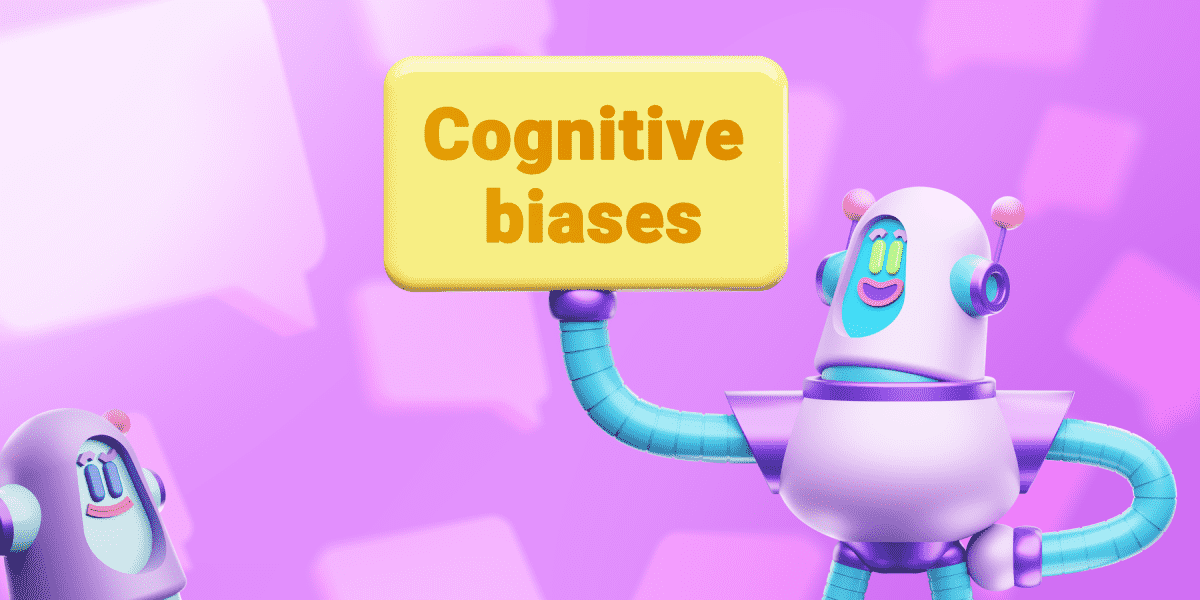
Table of Contents
What are cognitive biases?
In the 1970s, psychologists Amos Tversky and Daniel Kahneman coined the term cognitive bias to describe people’s flawed patterns of thinking when reaching decisions and making judgments.
Simply put, cognitive biases happen when our brains try to simplify information processing. Mind you, this simplification is more than necessary.
Namely, according to an article on neuromarketing techniques, our brains receive around 11 million bits of information per second, but our conscious mind can process only 40 bits of information.
So, speed is of the essence here. And, the way to achieve this processing speed lies in the process called heuristics. These are mental “shortcuts” we use to quickly solve a problem.
However, they’re often mixed up with cognitive biases.
Hence, before we dive deeper into the affluent world of cognitive biases, let’s see what cognitive biases are not, but are often thought to be.
The difference between cognitive biases and heuristics
Let’s start with heuristics.
According to APA Dictionary of Psychology, heuristic is “an experience-based strategy for solving a problem or making a decision that often provides an efficient means of finding an answer but cannot guarantee a correct outcome.”
But, how do we differentiate them from cognitive biases?
In their article Judgment under Uncertainty: Heuristics and Biases, Tversky and Kahneman claim that, although highly useful and usually effective, sometimes heuristics lead to cognitive biases and other types of systematic errors.
So, to be clear, we use heuristics to simplify making decisions, and sometimes this leads to cognitive biases.
To be even clearer, let’s illustrate this difference with an example.
Let’s say your coworker Dieter usually keeps to himself and doesn’t participate in office chitchats. You assume he is arrogant and self-absorbed, when he is just reserved and quiet. Still, in an effort to quickly form an opinion on this person, you use heuristics and make this assumption.
However, this heuristic may lead to a cognitive bias called the horn effect — when your perception of this person is influenced by a single negative trait.
Eventually, because of this bias, you might decide you don’t want anything to do with this person.
The difference between cognitive biases and logical fallacies
Another term people often confuse with cognitive bias is a logical fallacy.
However, there is a difference between them.
Namely, a cognitive bias refers to systematic errors in information processing, while a logical fallacy refers to errors in logical reasoning.
Furthermore, a cognitive bias affects our understanding and processing of information, whereas a logical fallacy weakens or invalidates our argument.
Again, let’s clarify this difference with an example.
Actually, we’ll elaborate on a previous example with shy Dieter wrongfully labeled as arrogant.
The logical fallacy that might stem from the horn effect is ad hominem.
Let’s look at the Pumble example below.
Dieter suggested to Karen’s team that they should change the design of templates for social media posts because they’re outdated.
Karen’s response is an example of the logical fallacy ad hominem. She attacks Dieter’s character, instead of addressing the substance of the argument.
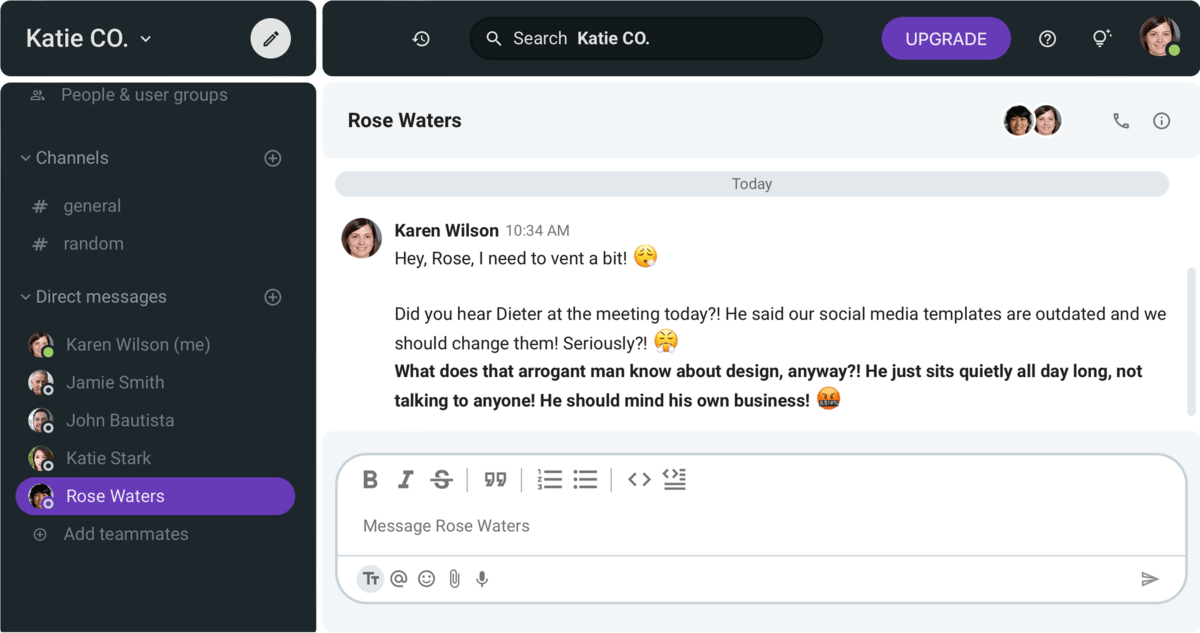
Causes of cognitive biases
When it comes to the causes of cognitive biases, the most common factors that contribute to them are:
- Heuristics — These mental shortcuts sometimes make us err in our judgment and decision-making.
- Emotions — They sometimes cloud our judgment and lead to cognitive biases.
- Our limited ability to process information — In case of information overload, we might feel the effects of our mind’s limitations, and that’s when cognitive biases occur.
- Aging — Our cognitive abilities decrease with age, making us more susceptible to cognitive biases.
Additionally, in his book Thinking, Fast and Slow, Daniel Kahneman writes about two types of cognitive processes — System 1 and System 2.
System 1 is our brain’s automatic and quick response system, over which we don’t have voluntary control and which requires little or no effort.
System 2, on the other hand, calls for more complex mental activities. It is associated with concentration and slower, more controlled thinking.
It’s important to note, however, that heuristics, and, consequently, biases, are the result of our brain’s juggling with these two systems, at least according to this theory.
| System 1 | System 2 |
|---|---|
| Associative | Rule-based |
| Fast | Slow |
| Governed by emotions and habits | Subject to logic and rules |
| Difficult to control | Controlled |
| Subconscious | Self-aware |
How do cognitive biases impact our workplace?
According to a study done by Coqual, which surveyed around 3,500 professionals, cognitive biases dramatically influence the work environment and company culture.
Namely, cognitive biases have a significant negative effect on the following:
- Employee retention — When employees perceive bias in the workplace, they are 3 times as likely to change their jobs in the following year.
- Employer branding — After noticing biases in the company, employees are 5 times as likely to badmouth their employer on social media.
- Engagement — Cognitive biases in the workplace make employees twice as likely to be disengaged in the workplace and hold back their ideas.
Additionally, on an individual level, cognitive biases:
- Affect our decision-making skills,
- Negatively impact our problem-solving capabilities,
- Slow down our career prospects,
- Make us less likely to respond adequately in crises,
- Damage our relationships with our coworkers, and
- Increase anxiety.
How do cognitive biases affect our business communication?
In today’s business world, more than ever, effective communication is a must.
However, sometimes, it is not a given, due to:
- Information overload,
- Time constraints, and
- Our own cognitive limitations.
All these factors force us to use the aforementioned heuristics, which, although enabling more efficient processing of information, can lead to cognitive biases — an often cause of miscommunication.
Namely, cognitive biases may distort the message:
- During its encoding by the sender, or
- During its decoding by the recipient of the message.
In both cases, the result is ineffective communication.
So, to avoid communication breakdown, it’s crucial to understand different types of cognitive biases.
—
Now that we know how cognitive biases impact our workplace in general, as well as workplace communication, let’s take a look at the most common cognitive biases and how to overcome them.
10 Most common cognitive biases and how to overcome them
Due to the more and more connected world, where misinformation and poor decisions are an everyday occurrence, we need to do everything in our power to break free of cognitive biases — in the workplace especially.
However, the challenge presented before us is enormous — there are over 170 types of cognitive biases. The silver lining is the fact that, naturally, some cognitive biases are more common than others.
That’s why we’ll dial down the pressure — we’ll choose the most common cognitive biases that influence us daily and offer you ways to mitigate them.
Bias #1: Confirmation bias
Confirmation bias means that we look for evidence that confirms what we already think or believe in. In other words, we choose to believe what we want to believe.
Here, technology doesn’t help either.
Namely, do you know what a filter bubble is?
A term coined by Eli Pariser, a filter bubble describes how automated personalization, used by search engines and social media, can isolate us from information that we might not find appealing.
This is a perfect ecosystem for breeding confirmation biases.
The aforementioned filter bubble makes sure we are only served information that we want to hear, that is in accordance with our already existing beliefs.
So, if you look at your Twitter feed, you might find that you agree with a great majority of statements or news fed to you.
Unfortunately, this is how our worldviews become limited, since we’re no longer exposed to alternative perspectives.
Still, even when we do seek contrasting information, we tend to be more skeptical toward them because we want to believe we’re right.
All in all, confirmation bias is detrimental to effective communication, in professional, as well as our private lives. It prevents us from truly listening to others and empathizing with them. Consequently, we’re less likely to help them if needed.
How to overcome confirmation bias
Overcoming a bias is not an easy feat — mostly because we’re unaware that we’re biased.
However, when it comes to confirmation biases, we have 3 tips for overcoming them:
- When looking for information, make sure that you use reputable sources. — Don’t just go for any evidence that confirms your belief. Rather, double-check whether the source is credible.
- Prepare yourself for being uncomfortable. — If you want to gain an objective take on the matter, you need to do the thing we all hate doing — get out of your comfort zone. To do just that, read newspapers that aren’t your usual source of information. Moreover, follow people you don’t necessarily agree with. This would give you the chance to hear people with opposing views. Also, don’t rely too heavily on your social media, since we’re usually friends with people with similar worldviews.
- Challenge your views. — This one might be the hardest of them all, but it’s a surefire way to fight confirmation bias. Discuss the matter with people who don’t share your views. Or, be the devil’s advocate — it’s a fun exercise in challenging your views.
Bias #2: Hindsight bias
Hindsight bias lets us convince ourselves after an event that we knew the outcome beforehand.
Do you know the saying “Hindsight is 20:20”? Well, that’s the essence of this bias.
This bias is especially dangerous because it causes overconfidence in our ability to predict other events in the future, which may lead to taking unnecessary risks.
Additionally, this bias is so alluring because it leads us to believe that the world is a predictable place and that there’s a pattern to it.
Unfortunately, as we all know, that’s not the case.
Consider the Pumble example below.
Milo and Rose are discussing a game they watched the previous night, and Rose is convinced she knew what was going to happen. However, little does she know that she’s actually fallen prey to the hindsight bias.
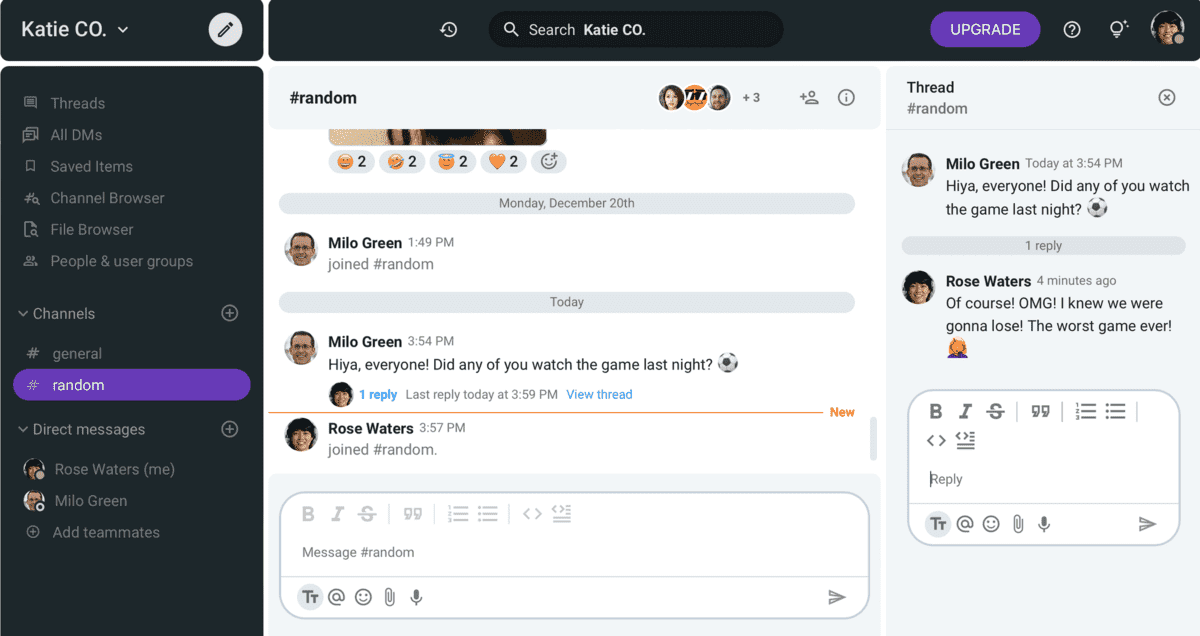
How to overcome hindsight bias
As we’ve already mentioned, this bias may lead to overconfidence in our abilities to predict future events, which can be dangerous in business.
Namely, this kind of behavior can negatively influence our decision-making.
However, there is an antidote to this bias — we just need to make a bit of an effort.
Here’s our advice on how to do it:
- Keep track of your past decisions and predictions. — It’s useful to keep a diary of major decisions and make a note of what your prediction for that decision is.
- Think of alternative outcomes. — After the event, try to come up with other possible outcomes that could, but have not, transpired.
- Review your predictions sporadically. — Keeping a diary is like having a conversation with your past self. You have evidence of how right or wrong you were with your prognosis. This might curb your confidence in your clairvoyant abilities.
Bias #3: Self-serving bias
Self-serving bias is our inclination to attribute positive outcomes to our own character and negative outcomes to external factors.
This type of bias can be especially detrimental to employees’ accountability in the workplace. Specifically, by not owning up to our mistakes, we can seriously damage our team’s productivity and trust among our teammates.
Let’s look at a Pumble example of self-serving bias.
Alice was late to the meeting, so she’s apologizing to her manager Christina.
However, instead of owning up to her transgression, she’s giving excuses — citing superior forces as the culprit for her being late.
Thereby, she’s demonstrating a self-serving bias.
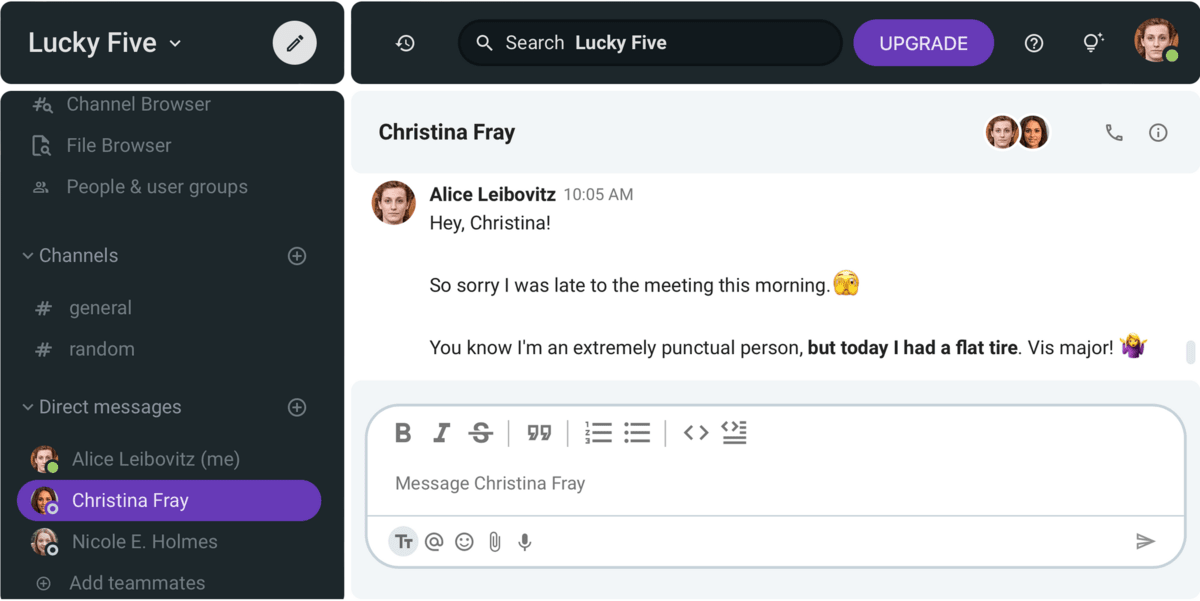
How to overcome self-serving bias
Although we may all fall prey to this bias from time to time, this doesn’t mean we should accept this predicament.
In other words, there are ways to prevent this bias:
- Work on your self-awareness. — If you’re aware of your shortcomings and not afraid of admitting them, you’ve made the first step toward successfully dealing with this bias. The more you learn about self-serving bias, the more you will notice it. This is the best way to start self-correcting.
- Don’t be (too) hard on yourself. — Even when you notice this bias in your behavior, you shouldn’t berate yourself. Be self-compassionate and work on your accountability.
- Be mindful of your coworkers. — Think about how you would react if your colleague had done the same thing you did. If they were late, would you label them as irresponsible, or would you try to understand their reasons for being late?
Bias #4: Anchoring bias
Anchoring bias is our propensity to rely too heavily on the first piece of information we are offered during our decision-making — the so-called anchor.
The anchor defines the further flow of our judgment process — i.e. we are influenced by that first information.
For example, anchoring biases frequently occur during salary negotiations.
Namely, the first offer made serves as an anchor and determines the rest of the negotiation, including the very outcome.
That being said, anchoring is an inextricable part of effective persuasive communication.
So, if you want to ask for advance payment or negotiate your salary, this is the technique for you.
This might work in your favor when you’re the one dropping the anchor, but what should you do when you’re on the receiving end?
Well, stay vigilant and follow our advice.
How to overcome anchoring bias
Since anchoring bias can seriously diminish your chances of having successful negotiations, there are certain strategies you can use to avoid becoming its victim:
- Be aware of the bias. — This is the crucial and hardest step. However, when you’re preparing for negotiations, remind yourself that the other party will probably try this technique. So, stay on your toes!
- Drop your own anchor. — It’s up to you to try and be wiser than your opponent in negotiations. To prevent them from deciding on the flow of the conversation, be the one that sets the stage. Maybe this sounds a bit counterintuitive — you won’t be overcoming the bias itself, but you’d rather be using it to your advantage.
- Be patient. — Delay the decision. Take your time and gauge all the options carefully. There’s no need to jump the gun.
Bias #5: Availability bias
Availability bias is our tendency to believe that the information that readily comes to our mind is more important than those that we don’t recall so quickly.
Here’s an example:
Let’s say you read in the newspapers that there will be massive layoffs in the next few months. As a diligent worker, you have no reason to worry. However, this information — so fresh in your mind — might keep you up at night in fear of being fired.
This cognitive bias makes us miss the big picture — that we’re good workers who don’t have to worry about being let go from the job. Instead, we make incorrect assumptions that this news concerns us.
How to overcome availability bias
Taming this bias requires a bit of effort, but it’s possible with our set of tips:
- When in doubt, brainstorm. — If you think you might be affected by this bias and are afraid of the consequences of your decision or situation, seek help from your coworkers. See what they think about the problem you’re facing, and check whether it’s all in your head.
- Don’t rush your decisions. — If you have enough time to weigh your options, do that — don’t make any hasty decisions you might regret afterward.
- Filter the information that comes to you. — Always set high standards for information analysis. It’s better to be overly critical and suspicious than to pay the price of becoming a “victim” of your mind.
Bias #6: The Dunning-Kruger effect
The Dunning-Kruger effect occurs when, due to a lack of self-awareness, people overestimate their knowledge or competence in a certain skill or field.
In other words, their perception of their own skills doesn’t match reality.
Namely, according to psychologists David Dunning and Justin Kruger, who introduced this bias in their paper in 1999, people who fall victim to the Dunning-Kruger effect suffer from it in two ways:
“Not only do these people reach erroneous conclusions and make unfortunate choices, but their incompetence robs them of the metacognitive ability to realize it.”
But, how does that look in the workplace?
You surely know that one person in your company who’s always so convinced they are good at any task they’ve been assigned and never seek other’s opinions. However, they’re not that good at everything. That person’s a perfect example of the Dunning-Kruger effect.
Our condolences to you, because these people are notoriously difficult to communicate and work with.
How to overcome the Dunning-Kruger effect
Again, we offer you a few tips that will help you avoid this bias.
- Never stop questioning your knowledge. — Always double-check the conclusion you draw, because we can always become victims of our own overconfidence.
- Be your own devil’s advocate. — Try to prove yourself wrong, even when you’re certain you’re right — especially then.
- Ask your colleagues for opinions. — If you want to make sure you don’t miss any blind spots, ask others for feedback or criticism.
Bias #7: In-group bias
In-group bias is our tendency to favor people from our own group over others.
In other words, we’re more likely to believe someone from our group than outsiders.
This bias is especially dangerous during talent selection or the hiring process, because it might make recruiters less objective.
Let’s look at the Pumble example below.
Alice Leibovitz is a Talent Acquisition Specialist and is currently searching for a new Associate Product Manager. She’s discussing her options with her colleague Nicole E. Holmes, suggesting they should hire a person who went to Yale, just like them.
Naturally, she’s unaware that she’s a victim of in-group bias.
Moreover, this might cost their company innovative ideas, since they are more common when there is diversity in the team.
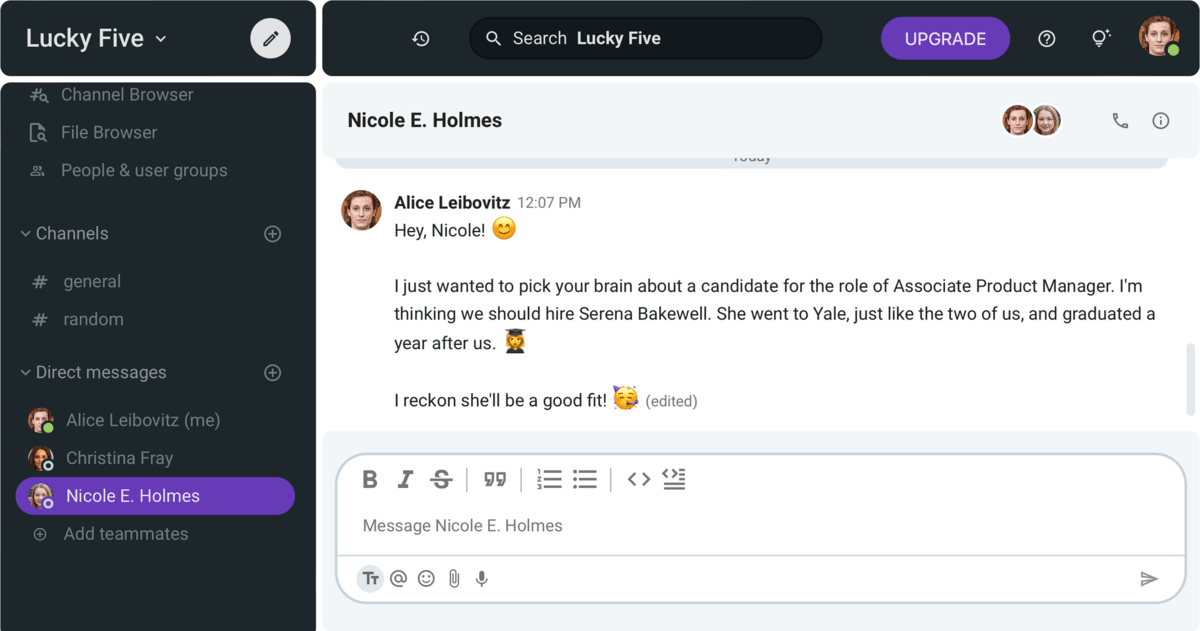
How to overcome in-group bias
It’s in our nature to want to belong — we’re social creatures. As much as it’s natural that we seek companionship from similar people, this habit of ours is detrimental in the workplace.
That’s why we’re giving you a set of tips for overcoming it:
- Think hard about your group. — What makes someone a part of your group? Is it age? Or gender? Or maybe similar interests? Whatever your answer might be, if you want to overcome this bias, you need to become aware of the factors that make you favor one person over another.
- Talk to others about in-group bias. — Discuss with your coworkers how it feels to belong to a certain group. Listen to different opinions and perspectives and try to figure out whether some groups are favored over others.
- Take the implicit association test. — If you want to take matters even further and discover your hidden biases, do some of the Harvard tests. Don’t be surprised if you find out you’re more biased than you thought.
Bias #8: The halo effect
The halo effect occurs when we automatically make positive assumptions about a person based on their positive characteristics that we notice. Namely, our first impression of the person influences all of our subsequent judgments of them.
In a way, we’re attaching “a halo” to them, which prevents us from seeing their negative attributes.
For example, if we learn that our new colleague went to an Ivy League school, we might attribute all sorts of positive characteristics to them. We might think they’re smarter or more competent than us, although it doesn’t have to be the case.
In reality, that person may be lazy or difficult to deal with, but we won’t notice that because of our first impression and the halo effect.
How to overcome the halo effect
The halo effect can blind us in making informed decisions.
Fortunately, there is a way to overcome this cognitive bias, and we’re offering you 3 steps to deal with it.
- Be aware of the halo effect. — Just like with other cognitive biases, you have to be aware of this one, to battle it effectively. Namely, don’t forget that first impressions stay with us for a long time. However, they don’t have to match reality. So, stay vigilant!
- Don’t rush your decisions. — Take your time before reaching a decision that concerns new people who may have a halo in your mind. Before deciding on whether a candidate who wooed you with their charm is the best for the position, try to objectively consider all the facts.
- Seek others’ opinions. — It’s always better to do a quick reality check with your colleagues before making a decision. Maybe they aren’t influenced by the new candidate’s halo you’re blinded with. All in all, open communication is always key.
Bias #9: Status quo bias
Status quo bias is defined as our preference to maintain our current situation, at the same time opposing any type of change.
In other words, when we experience this bias, we have difficulties processing and accepting changes. For that reason, we find it more convenient to hold on to our current state of affairs.
For instance, imagine that you’ve been offered a position in another team in your company. The proposition is alluring, but you don’t know how the rest of the team members might accept you. What if you have trouble fitting in with them?
On the other hand, you’re in a great team now. You feel comfortable with your job responsibilities and have even made a work bestie.
In the end, you decide to reject the opportunity.
Hate to break it to you, but you might be experiencing status quo bias.
How to overcome status quo bias
Overcoming this bias is crucial if you want to achieve any kind of personal or professional success.
Whether you’re a manager leading a team or just an employee following a career path, status quo bias might seriously hinder your journey to success.
So, to prevent this from happening, here’s what you can do:
- Be aware of the bias. — Learn to recognize status quo bias. When someone proposes any kind of change in the workplace, pay attention to your reactions. If you notice that you’re afraid of it, try to dig deeper. Find out why that is so. Is there a rational reason for your fears, or are you simply afraid of the change?
- Make a list of pros and cons. — These lists are pretty useful when you want to look at the situation objectively.
- Change your perspective. — Frame the default option — i.e. not making any changes — as a loss. Consider what you would lose if you didn’t accept the change. Maybe the status quo would cost you more time and productivity.
Bias #10: Curse of knowledge
The curse of knowledge is a cognitive bias that occurs when a person assumes that everyone knows as much as they do on a certain topic.
In other words, the biased person has trouble remembering what it was like when they didn’t know something. They are cursed by their knowledge.
In their book Made to Stick: Why some ideas survive and others die, Chip and Dan Heath explain how and when this curse of knowledge kicks in.
Namely, when we become experts in a field, we become more and more obsessed with the details and nuances of a certain problem. That’s precisely when we start forgetting how it was when we didn’t know what we now know.
Let’s illustrate this with a Pumble example.
Jamie Smith, a lead designer in a marketing firm, is giving feedback to Rose Tennant in a group chat.
He tells her to “get rid of that widow”, which leaves Marie Smith, a new SEO specialist, perplexed.
Little does she know that Jamie suffers from the curse of knowledge — he was using designers’ jargon, which she’s unfamiliar with.
So, the widow Jamie was referring to is not a woman whose husband died, but rather a word left alone at the bottom of a paragraph.
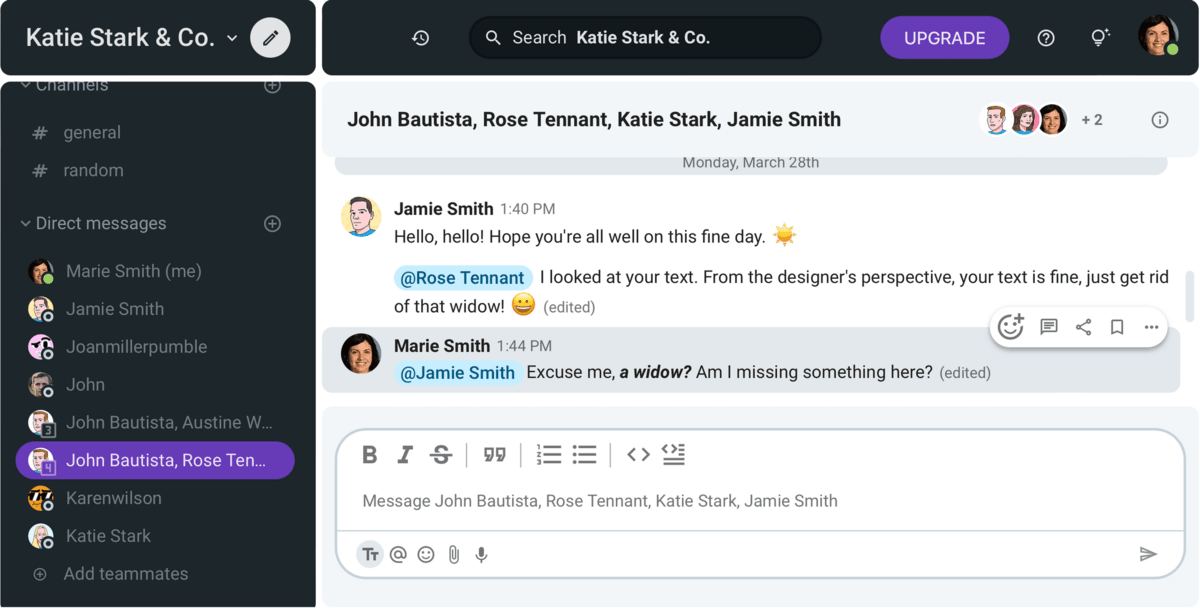
How to overcome the curse of knowledge
Putting yourself in the shoes of a less informed colleague and avoiding the curse of knowledge can be as easy as 123. All you need to do is follow our tips:
- Forget about the industry jargon. — Refrain from using buzzwords and industry-specific words if you want everyone to understand you.
- Don’t assume anything. — If you’re not sure what your coworkers’ level of knowledge on a specific topic is, ask them. It’s as easy as that! This will give you the chance to gauge their knowledge and adjust your language accordingly.
- Be patient. — Don’t lose your nerves when trying to understand your coworkers. Just because you’re an expert in your field doesn’t mean you’re smarter than them. Pace yourself and don’t be afraid to overcommunicate.
💡 Pumble Pro Tip
If you’re not ready to ditch the industry jargon completely, we have some pointers on when it’s acceptable to use it, and when it’s a no-go:
3 Extra expert tips on disrupting cognitive biases
Now that we’ve seen some of the most common cognitive biases — and considered ways of overcoming each of them — it’s time for a cheat sheet for disrupting the biases in general.
We’ve contacted several experts to help us come up with a set of tips.
So, let’s see what they have to say about disrupting cognitive biases.
Tip #1: Be aware of the biases
First and foremost, all our experts agree that we should strive to become aware of our biases.
One of our contributors, Kelly Neupert, a licensed psychotherapist and career coach, is well aware of how difficult it is to see through our biases.

“Most of our cognitive biases are unconscious. The first step to tackle irrational thoughts is to become more self-aware of what they are and when they’re happening.”
For Jeanette Lorandini, a licensed clinical social worker and the owner of Suffolk DBT, this means we should gather as much information as we can before reaching a decision.

“The best way to overcome cognitive biases is to be aware of them and take steps to manage our biases. For example, we can focus on gathering as much information as possible before making a decision or forming an opinion. This will help us make sure that our conclusions are based on facts rather than assumptions.”
Moreover, Ellie Borden, a registered psychotherapist, clinical director, and clinical supervisor, pointed out that we all have biases, and elaborated:

“This can be challenging, as it may require you to not easily dismiss others as being nefarious or unethical, even if you are tempted to because of your personal feelings toward them. However, if you can manage to do so, it can make you a clearer thinker.”
So, we’re all the same that way — we all have biases we need to become aware of.
Tip #2: Challenge your beliefs
Becoming aware of your biases, however, is no simple task.
For this to happen, it requires us to challenge our beliefs, as Lorandini explains:

“We should also strive to think critically and consider alternative perspectives when making decisions or reaching conclusions.
It’s important for us to challenge our own beliefs and ideas in order to move beyond our comfort zone — this will help us become more open-minded and reduce the likelihood of relying on biased thinking.”
In other words, challenging our views and perspectives will make us more open to the ideas of others, which is a surefire way to combat our biases.
Tip #3: Consider different perspectives
Finally, our experts suggest we take other people’s perspectives into account when trying to make a decision.
Ellie Borden highlights the importance of hearing other perspectives in gauging our objectivity and fighting biases.

“Speak to other people in order to receive the benefit of their opinion. The more people you speak to and the greater the agreement between their perspectives, the more likely it is that what they are saying is accurate.”
Similarly, Kelly Neupert advises us to slow down our decision-making process, and allow ourselves to evaluate all perspectives:

“A great way of doing this is challenging yourself to spend as much time and energy proving your point as you do researching other arguments, points of view, and solutions.
Additionally, spend time surrounding yourself with and asking for perspectives from a diverse group. Try to position the questions or problems you have as neutrally as possible.”
Our coworkers’ perspectives are a valuable tool in creating a positive work environment, as Lorandini points out:

“Finally, it’s essential for us to respect different opinions even if they are not in line with ours; by doing so, we can create an environment that is conducive to more productive dialogue and collaboration.”
In other words, different perspectives bring us new opportunities for collaboration and save us from cognitive biases.
In conclusion: Overcoming cognitive biases is essential for a positive work environment
Cognitive biases are all around us, and we’re all prone to them.
However, that doesn’t mean we should accept our fate blindly and continue to err in our judgments and decision-making.
Namely, we have given you a set of tips for overcoming each of the 10 most common cognitive biases. Moreover, our contributors helped us come up with 3 general rules for overcoming biases.
Now, it’s up to you to take the matters into your own hands:
- Know your biases,
- Challenge your beliefs, and
- Acknowledge different perspectives.
If you follow our advice, you might just learn to cope with these omnipresent nuisances called cognitive biases.
✉️ What about you? Do you notice cognitive biases in your work environment? How does it impact your workplace? Do you have any additional tips on overcoming cognitive biases in the workplace?
Share your experience and tips at blogfeedback@pumble.com and we may include your answers in this or future posts. And, if you found this blog useful, share it with someone you think would also benefit from it.





